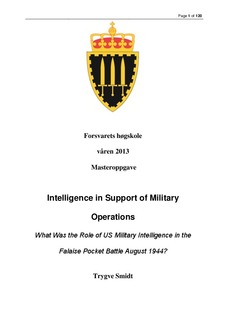| dc.description.abstract | On 13 August 1944 the German armies in Normandy were on the verge of being totally enveloped. This study has explored the role military intelligence played for Bradley’s vital decision to halt Third Army and keep it from closing the German’s escape route. This study has looked at how Bradley’s intelligence staff assessed the enemy situation, enemy capabilities and other factors liable to influence the course of action. An assessment has been made on the precision of intelligence in 12th Army Group and how it was received and utilized. This study has analyzed actual World War II intelligence reports and commander’s briefings together with after action reports. Bradley’s intelligence staff was able to describe the flux of units in the area of operations. However, there were flaws in analysis of combat strengths. Imprecise assessments of the actual US – German force relationship was probably a major factor which led to the decision to halt Third Army from closing the Falaise Gap, an objective they probably would have achieved estimating the available forces at both sides | no_NO |
